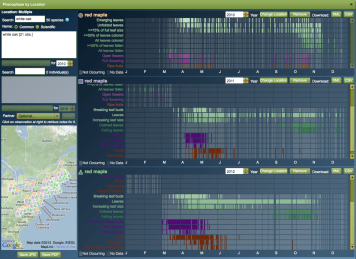
When walking through the woods, do you ever wonder whether the maple leaves are changing color later in autumn now than in previous years? Or whether the poplar trees are flowering earlier each spring? Do you see potential support for the hypothesis that a bumper crop of acorns follows within a year or two of a winter with high snowfall levels?
Observations on the timing of seasonal changes can provide important clues about how and to what extent local climates and environments might be changing. These observations become more significant when they are collected by many people in a scientific way—that is, when observations are reported every week and include specific details about what events occurred and when and where they happened. The Nature’s Notebook program encourages this type of record keeping, with the help of thousands of participants across the nation.
Nature’s Notebook is a national online program used by amateur and professional naturalists to record observations about the natural world. The program was developed by the USA National Phenology Network (USA-NPN). For background on Nature’s Notebook, the USA-NPN, or the study of nature’s calendar, see the related article Science of Phenology: Tracking Plant and Animal Responses to Climate in a Systematic Way.
You can participate in the Nature’s Notebook program by becoming an observer. Forest owners, scientists, and other observers who participate in Nature’s Notebook can use the program’s visualization tool to consider their own questions about short-term seasonal changes by viewing data. They can visually compare year-to-year data and other types of data for a particular species. Also, they can cross-reference such data with weather and climate information to make predictions and recommendations.
Data gathered on trees and shrubs across the United States are stored in USA-NPN’s National Phenology Database. Figure 1 is a visualization that uses such data to show a comparison of specific observable life cycle stages of red maple, Acer rubrum, in the northeastern United States for the years 2010, 2011, and 2012. For more examples of how the data are being used, visit USA-NPN’s How your data are being used page and check out the results of the spring 2012 campaign Was Spring 2012 as early as Spring 2010?.

Besides becoming a Nature’s Notebook observer, another way to contribute data and learn more about changing conditions in your area is by participating in USA-NPN’s Cloned Plants Project. You can order and plant cloned lilacs or cloned dogwoods (or just observe any nearby individuals of these shrub species) and then synchronize your findings with observations that date back to the 1950s.
If you want to involve Nature’s Notebook in your forest or community or research project, visit the USA-NPN website for more information and then sign up to begin collecting data on your land. As an example, Idaho forest owners recently participated in a Nature’s Notebook workshop in which they learned how to observe and record habitat information and species arrival dates, how Nature’s Notebook can help with developing forest management plans, and whether certain habitats are being used.
Many Cooperative Extension System programs collaborate with USA-NPN to collect and share data. To find out whether your local Cooperative Extension office is participating, contact LoriAnne Barnett, Education Coordinator for USA-NPN. If the personnel at your local office are not yet participating, you can encourage them to do so.
From data you compile based on your observations, you will be able to tell the story of your land. When individuals work together to tell their stories, we can determine whether there is any truth to the idea that spring is arriving earlier now than in the past or the lore that acorn bumper crops follow snowy winters and dried oak leaves remaining on trees in October mean a rough winter ahead. Moreover, we will better understand what is happening with climate and be able to address the implications of climate changes. Changing climatic conditions will influence many ecosystem factors around the globe, including the location of certain tree species, the range of certain bird species, and the activity of invasive insects and other pests.
LoriAnne Barnett is the Education Coordinator for the USA-NPN. She often works with Cooperative Extension professionals on relevant projects.
Contributor
LoriAnne Barnett, USA-NPN
For More Information
USA-NPN Cloned Lilac and Cloned Plant Project
USA-NPN and Cooperative Extension
